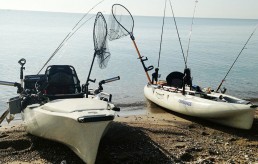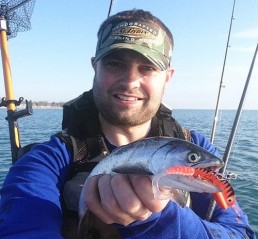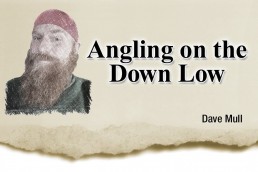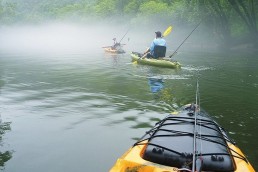Kayak Cohos: Reaching Past a Cast from Shore
SHARE THIS POST
Planning ahead is important to the success of any fishing outing. For the weekend warrior with time constraints, it is even more imperative that preparation “rituals” are strictly adhered to. While batteries can be recharged, rods relined, and tackle reorganized, there are variables beyond our control that can crush time on the water.
One of the most devastating things for a busy weekend warrior angler is a miscalculated weather forecast. This is quite common during the spring in the Midwest due to extremely unpredictable weather. As a kayak angler, it is even more important that the weather cooperates, especially if one chooses to chase aggressive coho salmon off the shores of southeastern Wisconsin. While many smaller motorized vessels are capable of handling 2- to 3-footers, conditions need to be awfully stable for yak anglers to feel safe on the big pond. Having the ability to fish just beyond the distance where shore anglers can reach often gives the kayak angler an edge.
On a recent trip, plans fell into place perfectly. Weather patterns stabilized and were predicted to last through the end of the week. By Friday, conditions were perfect. The evening before, I secured my Hobie Outback to the roof of my vehicle and set the alarm early to allow plenty of travel time. As a beginning kayak angler, I felt it extremely important to fish with another angler for safety reasons and to improve my technique. Fortunately, I was able to connect with an incredibly experienced angler, Rob Wendal, aka, “Great Lakes Kayak Angler.”
Rob religiously spends time on Lake Michigan chasing fish by kayak from northern Illinois up to Milwaukee. I couldn’t think of anyone better to guide me onto some tasty spring cohos. As I pulled up to my destination that morning, I couldn’t help but smile as the sun began to illuminate the glassy water of Lake Michigan. With a full mug of coffee in the belly, a breakfast sandwich down the hatch, and a great night of sleep, I was starting to feel like I was in a dream. Rob and I carried our vessels to the lake, and as we were about to push off, a small salmon starting jumping within 20 feet of the shore. It was pretty hard not to take a few casts toward the splash.
Once launched, Rob immediately began trolling to our destination while I worked to adjust my kayak’s mirage foot-drive pedals. No joke, within 30 seconds of Rob having his line in the water, it was fish on! Rob hooked up with a perfect eater coho on a 1/2-ounce Tommy Harris Orange Tiger Echotail tipped off with a Green Kalin’s grub tail—the outlook for the trip was looking extremely promising.
The day before, Rob had limited out in a short time and I was pumped. To make a long story short, our morning slowed as the sun continued to rise. According to Rob, the water temps had cooled off a few degrees with winds shifting overnight to the west; water temps were holding around 46 degrees. In addition to cooler temps, the clarity of the water had improved from 5 to 6 feet of visibility to 10 to 12 feet. Cohos become a bit more skittish with clearer water, making it difficult to get them to commit into striking. Other boats around us were also struggling and I overheard one group state that they finally hooked after shutting off their trolling motor—more evidence for the wary clear-water concept. Working through water in stealth mode was key in successfully landing fish that day.
Are you enjoying this post?
You can be among the first to get the latest info on where to go, what to use and how to use it!
The softness of a kayak gliding through water was part of the equation. In addition to being stealthy, having the right equipment to make long “dive-bomb” casts was also essential. Making long casts started with having a quality rod. The day before the trip I picked up a 6-foot 6-inch St. Croix Avid X spinning rod from Dick Smith’s Bait & Tackle in Delafield, Wis. My thought process being that it would be less of a struggle to land a fish solo from a kayak with a shorter rod. As an added bonus, the Avid X is designed with a micro-guide platform, allowing for smooth line flow on the cast and allowing for maximum distance.
Fishing from a kayak can limit the ability to get a full backswing, as the cockpit is in such close proximity to equipment such as fishing rods, landing nets, safety flags and rod holders. These obstacles often limit mobility depending which direction a cast is desired. A slightly heavier spoon or blade-style lure is ideal due to its ability to load the rod like a whip on a short backswing without much effort. The small, thin weighted profile is extremely aerodynamic so the lure can cut through the air whether it’s windy or calm. Acme Spoons like the Kastmaster and Little Cleo are great choices when targeting any species of salmon on Lake Michigan. Another option is the 1/2- and 3/4-ounce Echotail blade bait, as it creates a tremendous amount of ruckus with its tight intense wobble. The back of the hybrid Echotail blade bait has a series of metal barbs, which makes it easy to change out soft Kalin’s soft plastics and even pork tails. This unique innovation allows anglers to quickly experiment with different colors until the fish are patterned. You can also utilize different fishing techniques with spoons and blade baits. Both are excellent for trolling, casting and vertical jigging.
Since space is limited in a kayak, anglers must be creative in choosing lures that can be utilized no matter what depth fish are in. Acme Spoons and Echotail Blade Baits come in a variety of sizes and weights designed to reach the water you are targeting. The Plano 3640 holds lots of metal and fits perfectly into the floor compartment of the 2015 (model) Hobie Pro Angler Kayak. In terms of color selection, Rob recommends lures that are orange when targeting spring cohos. In addition to using metal, Rob casts and trolls crankbaits such as the #7 Flicker Shad and Brads Thin Fish. As water temps start to climb, Rob also trolls orange flashers and flies behind his kayak.
Fishing for spring cohos from a kayak is an extremely enjoyable experience. The convenience of not having to depend on a nearby boat launch to gain water access is a huge advantage when angling on Lake Michigan. Boat launches are often a long distance from where anglers desire to fish. With many municipalities offering public lake access, kayak anglers have an edge when targeting cohos that are beyond a cast from a shore.
For more information…
For a delicious coho recipe, go to the website below and watch as pro angler Captain Eric Haataja prepares his favorite family recipe. Find recipes here on Pinterest.
MWO
SHARE THIS POST
Did you enjoy this post?
You can be among the first to get the latest info on where to go, what to use and how to use it!
Justin Blanchar
MidWest Outdoors works with more than 200 outdoor experts each year, who contribute articles based on their areas of expertise. MidWest Outdoors magazine offers more fishing and hunting articles than any other publication!




